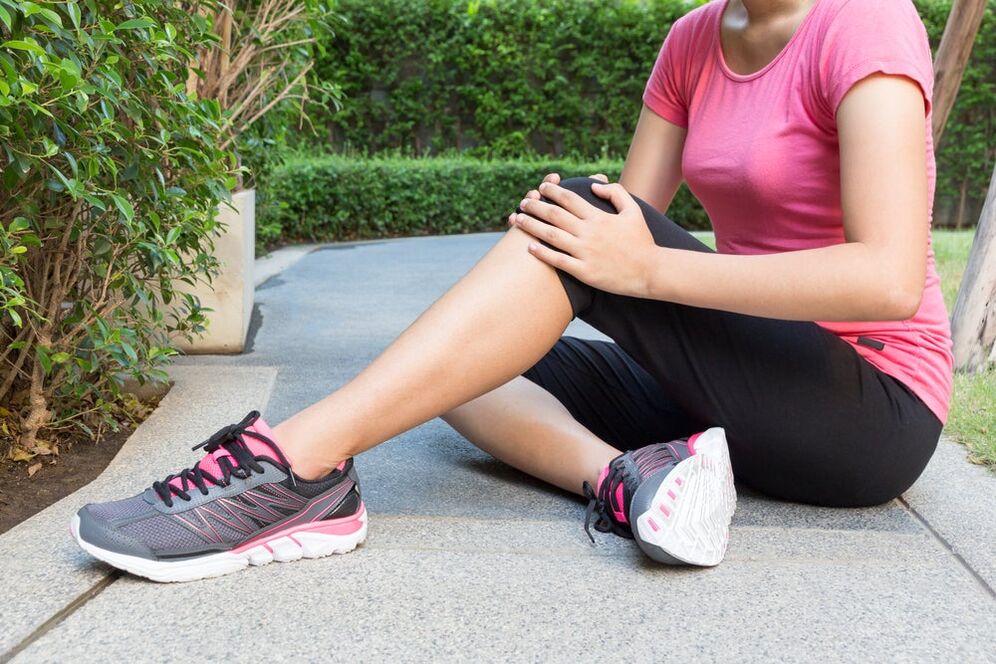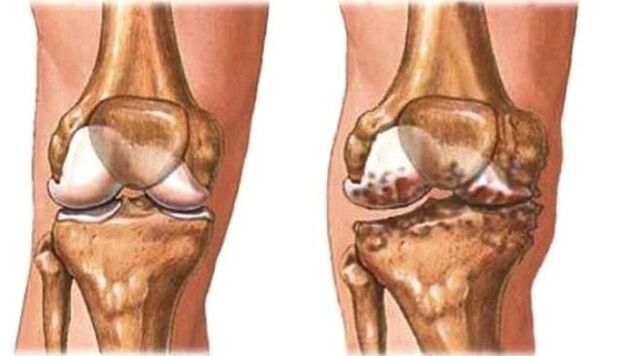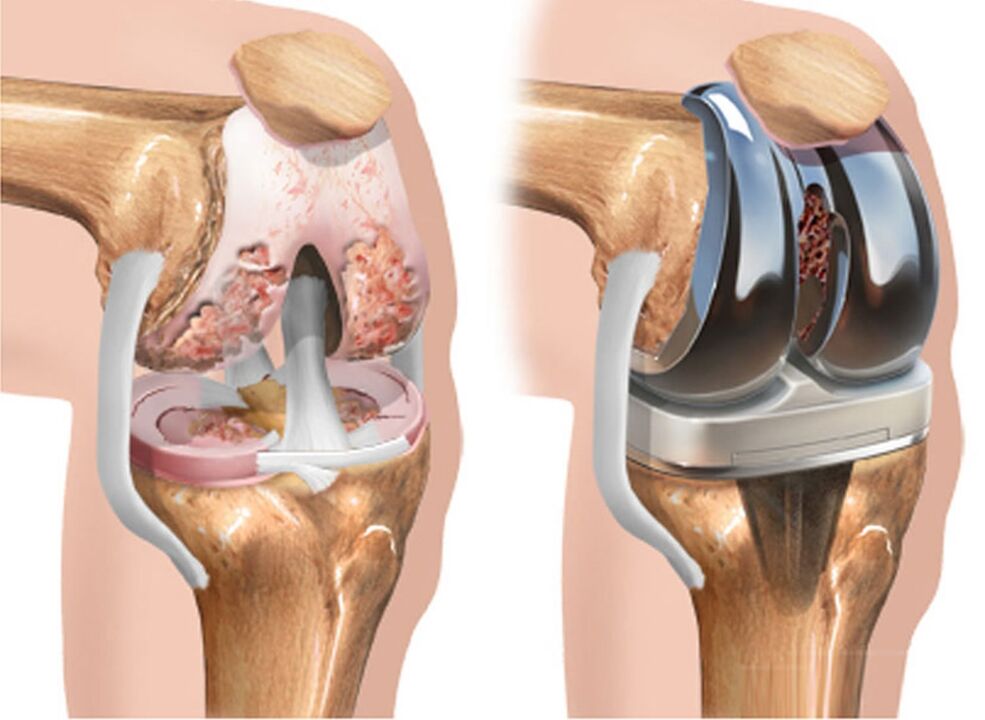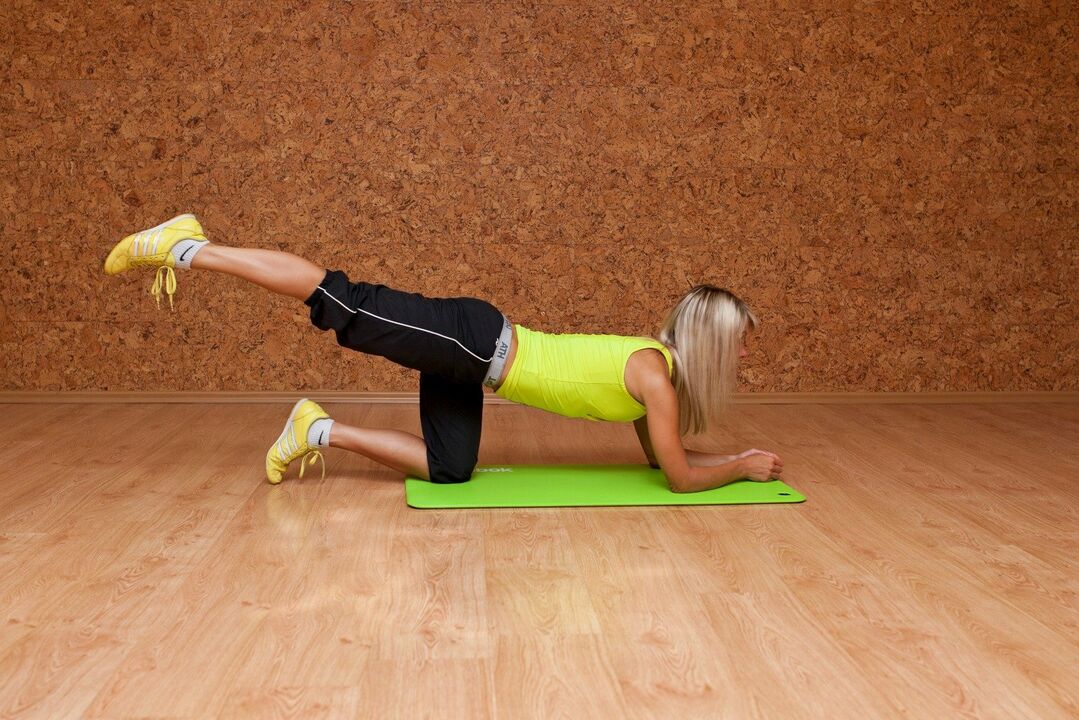
Knee arthropathy is a pathological process in the cartilage tissue of the knee joint, leading to its deformation. This process is related to the high pressure, wear and salt deposits on the knee.
Myths about knee joint disease
There are 3 most famous myths:
- "The diagnosis of knee joint disease is the prerogative of people with increased physical activity, mainly sedentary work people will not be affected. " In fact, excessive physical exertion is actually the cause of cartilage degradation. When working for a long time, the knee will produce static effect, and the blood supply will be blocked. In addition, a sedentary lifestyle can lead to weight gain.
- "Knee arthropathy of the knee joint cannot be cured. This disease is getting worse every day. " This disease is indeed chronic, but if treated in time, cartilage degeneration can be prevented.
- "For arthropathy, you need to move as little as possible and lie down more. " Patients with this pathology are assigned special gymnastics to strengthen the ligament device. Only a few sports are truly taboo.

Knee arthropathy is the destruction of articular cartilage on the knee joint and adjacent bone surfaces.
Manifestations of knee joint arthropathy
The performance depends on the severity of the deformity. The more it expresses, the more obvious the symptoms.
Arthritis symptoms:
- Long asymptomatic period;
- Discomfort in the knee area;
- Pain syndrome;
- Declining liquidity;
- Morning stiffness is up to half an hour;
- There is crunch during active exercise;
- Gait changes.
When the knee joints of both limbs are involved in this process, bilateral knee arthropathy will occur. This is one of the most serious forms. It is more common in the elderly.
Right knee arthropathy is manifested as excessive static or dynamic physical exertion of the right limb. It is more common among athletes.
Left knee joint disease occurs in overweight people and athletes with weight on their left leg.

Causes of knee joint disease
Knee joint disease is primary and secondary. Primary can occur in children and adolescence, which is related to deformed joints, and can also occur in the elderly due to the natural aging process.
Secondary occurs due to injury or existing illness. main reason:
- Fractures, bruises, dislocations;
- Excess weight;
- There is an inflammatory process in the joint and lack of adequate treatment;
- Metabolic diseases, accompanied by the deposition of salt in cartilage tissue;
- operate;
- Vitamin D deficiency;
- hormone imbalance;
- weightlifting;
- Some sports (running, hockey, football).
Who is at risk?
The risk group includes:
- Professional athletes;
- fat people;
- Patients who have experienced trauma or surgery;
- People over 45 years old;
- Patients with varicose veins;
- Those who suffer from joint disease in the family.
The risk group also includes women wearing high heels or flat shoes.

The exact cause of knee joint disease is unclear.
Degree of arthritis
In radiology, this pathology is divided into 5 stages or degrees:
- Stage 0-X-ray without joint disease;
- Stage 1-small osteophytes appear;
- Stage 2-The outline of the osteophyte is clear, and the joint space changes little;
- Stage 3-narrowing of the joint space;
- Stage 4-The gap is significantly narrowed and the subchondral bone is hardened.
Knee joint 1 degree
The first degree is characterized by fatigue, limited activity, mild performance, and the hearing of a crunch. Pain occurs after getting up, sitting for a long time, and after physical activity.
There is no deformation at this stage. X-ray film showed narrowing of the joint space.
How to treat knee joint disease?
For treatment, a special group of drugs-chondroprotective agents are used. They contain chondroitin and glucosamine, which can restore cartilage structure and increase elasticity. NSAIDs are used to relieve pain.
Primary knee joint disease is usually bilateral. Even with the development of the one-sided form of the disease, the second limb participates in the pathological process after a period of time.
Early symptoms of knee joint arthropathy are mild and atypical
treatment method
In addition to drug treatment in remission, the following methods are also used:
- physiotherapy;
- massage;
- Leech therapy;
- Ultrasonic exposure
- Radon and hydrogen sulfide bath;
- Voice, electrophoresis;
- Paraffin wrapped
- Use healing mud.
These methods can be used regardless of the stage of development of the disease during remission.
Is mud good for knee joint disease? One of the indications of mud therapy is diseases of the musculoskeletal system. The treatment process is carried out twice a year. It includes 10 to 15 programs. This method can be used at home, and the dirt can be purchased at a pharmacy.
In the first stage, the patient is prescribed orthopedic shoes during the deterioration period to prevent the development of the deformation process. It is recommended that women wear shoes with a platform of at least 1 cm and a heel of 5 cm. Normalize the diet-reduce the intake of salt and spicy food. Jelly meat and jelly are included in the diet because they are natural cartilage protectants.
Another method is weight correction. Reducing the weight of a particular patient to an optimal level will reduce the load on the musculoskeletal system.
Grade 2 arthritis
In the second degree, the pain worsens, so movement is obviously restricted. Long-term long-distance walking can cause severe pain syndrome. The patient needs to rest to continue.

If treatment does not start (or does not work), arthropathy of the knee joint will develop further.
The crunch became louder and the limp appeared. Deformation of the affected joint. The inflammatory process occurs in the lining of the joint.
On plain X-rays, the joint space narrowed and spines (osteophytes) appeared on the bones.
treatment
Medication is based on the use of non-steroidal anti-inflammatory drugs. They have analgesic and anti-inflammatory effects. In addition, chondroprotective agents are also prescribed.
After the condition worsens, perform physical therapy exercises and massage.
Dietary recommendations:
- Increase the quantity of vegetables;
- Add jelly and jelly meat to your diet;
- Eat lean fish twice a week;
- Lean meat is preferred;
- Eat bran bread.
It is also recommended to add bananas, nuts, eggs, spinach, beans, liver, and cabbage to the diet.
In addition to orthopedic shoes, special knee pads are also specified.
From surgery, an arthroscopy is used to remove deformed tissue. This method has a short-term effect of 2-3 years.
Knee gonorrhea, grade 3 symptoms and treatment
The most serious degree. Pain syndrome occurs during exercise and rest. The mobility of the knee is as limited as possible, sometimes even impossible. The deformation is obvious. There is almost no joint space on the X-ray film.

The gradual destruction of cartilage and bone in the final stages leads to the development of ugly deformities of the knee joint, which increases in size.
treatment
At this stage, in addition to non-steroidal anti-inflammatory drugs, hormonal drugs will be prescribed to patients. They are injected intravenously or intra-articularly. Severe pain syndromes can be relieved with analgesics.
In the third stage, the surgery has been demonstrated-the endoprosthesis. Replace individual bone elements or entire joints. Contraindications: Osteoporosis.
Complications of joint replacement surgery:
- Peripheral skin necrosis;
- Reject prostheses;
- Neurovascular diseases (paralysis, thrombosis).
In addition to endoprostheses, there is arthrodesis-removal of deformed tissues and joints. It is rarely used.
Osteotomy-The edge of the bone is removed to redistribute the load.
physiotherapy
Exercises for knee joint disease can relieve pain, strengthen muscles and organs, and stimulate blood flow to them.
- Exercise #1. The patient lies on his back, raises his straight leg and holds it for at least 30 seconds, then the second one. The execution time should be 2 minutes.
- Exercise number 2 "Bicycle". Lie on your back and imitate riding a bicycle with your feet. Repeat 20 to 50 times.
- Exercise number 3. The patient lies on his stomach, bending his legs alternately, trying to reach the buttocks with his heels. Repeat 20-50 times.
- Exercise number 4. It is done in the same way as the previous one, just static. In other words, the patient holds the limb in this position for 20-30 seconds.

Advise patients to stretch:
- Exercise #1. In a standing position, bend down and try to reach the floor without bending your knees. Hold for 20 seconds, inhale air through your nose and exhale through your mouth.
- Exercise number 2. Sitting on the floor with your legs straight, try to wrap your arms around your feet while keeping your knees straight. Maintain this position for up to 30 seconds. Perform 2-3 methods. If they are not flexible enough to reach the feet, they will grab the calf and try to get their body as close to the leg as possible.
- Exercise number 3. The position is the same as when the previous one was executed. The patient grasps the foot with the foot, tries to straighten it and raise it as high as possible above the floor. If the exercise is difficult, place the leg in the calf area. Maintain this position for 10-30 seconds, then switch to the other leg.
Contraindications are the presence of exacerbations and acute inflammatory processes. The patient is forbidden to run, walk long distances, and squat.
After performing physical therapy exercises, it is useful to massage the thigh and calf muscles of the affected limb. The joint itself should not be affected, which will increase inflammation.
prevent disease
This disease is not hereditary, so its development can be prevented. this needs:
- Avoid injury during exercise;
- Do stretching exercises, joint gymnastics, and yoga;
- Reasonable diet
- Maintain a normal weight;
- If you feel any discomfort in the knee area, please consult a doctor;
- Drink enough water;
- After 40 years, take chondroprotective agents preventively;
- Don't overcool the joints;
- In the early stages of the process and during the remission period, do not increase physical activity and do not run;
- Wear orthopedic shoes;
- Use knee pads when exercising.














































